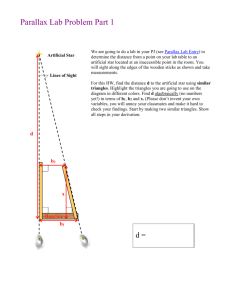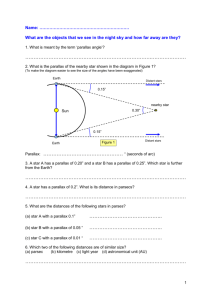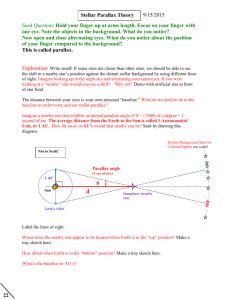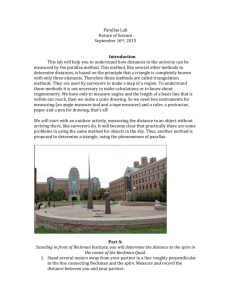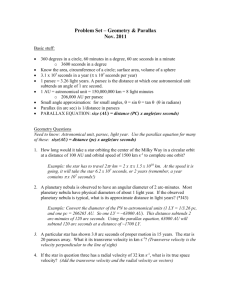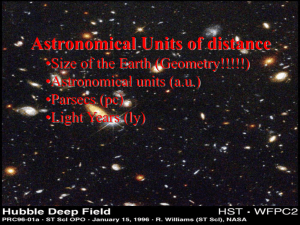Parallax of Stars: Measuring Distance in Astronomy
advertisement
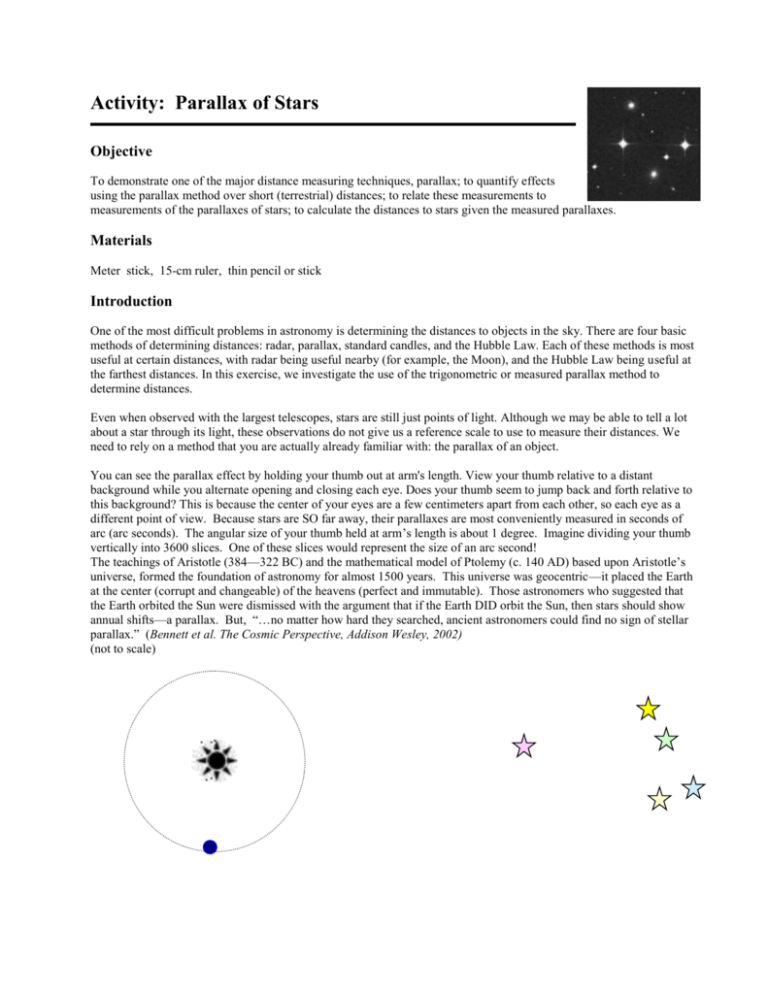
Activity: Parallax of Stars Objective To demonstrate one of the major distance measuring techniques, parallax; to quantify effects using the parallax method over short (terrestrial) distances; to relate these measurements to measurements of the parallaxes of stars; to calculate the distances to stars given the measured parallaxes. Materials Meter stick, 15-cm ruler, thin pencil or stick Introduction One of the most difficult problems in astronomy is determining the distances to objects in the sky. There are four basic methods of determining distances: radar, parallax, standard candles, and the Hubble Law. Each of these methods is most useful at certain distances, with radar being useful nearby (for example, the Moon), and the Hubble Law being useful at the farthest distances. In this exercise, we investigate the use of the trigonometric or measured parallax method to determine distances. Even when observed with the largest telescopes, stars are still just points of light. Although we may be able to tell a lot about a star through its light, these observations do not give us a reference scale to use to measure their distances. We need to rely on a method that you are actually already familiar with: the parallax of an object. You can see the parallax effect by holding your thumb out at arm's length. View your thumb relative to a distant background while you alternate opening and closing each eye. Does your thumb seem to jump back and forth relative to this background? This is because the center of your eyes are a few centimeters apart from each other, so each eye as a different point of view. Because stars are SO far away, their parallaxes are most conveniently measured in seconds of arc (arc seconds). The angular size of your thumb held at arm’s length is about 1 degree. Imagine dividing your thumb vertically into 3600 slices. One of these slices would represent the size of an arc second! The teachings of Aristotle (384—322 BC) and the mathematical model of Ptolemy (c. 140 AD) based upon Aristotle’s universe, formed the foundation of astronomy for almost 1500 years. This universe was geocentric—it placed the Earth at the center (corrupt and changeable) of the heavens (perfect and immutable). Those astronomers who suggested that the Earth orbited the Sun were dismissed with the argument that if the Earth DID orbit the Sun, then stars should show annual shifts—a parallax. But, “…no matter how hard they searched, ancient astronomers could find no sign of stellar parallax.” (Bennett et al. The Cosmic Perspective, Addison Wesley, 2002) (not to scale) Procedure Let's test how the parallax of an object varies with distance. Follow these instructions and write your answers on the answer sheet as you go along. One partner takes the meter stick and places the pencil at the 50 cm mark, centering the pencil on the meter stick. The other partner places the "zero" end of the meter stick against her/his chin, holding it out horizontally. This partner then alternates opening and closing each eye, noting how the pencil moves against specific background object s. Have your partner move the pen half of the original distance (to 25 cm). When you alternate opening and closing each eye does the pen appear to move more or less than before? Try to quantify how much more or less (twice as much? half as much? three times as much? etc.). Now, have your lab partner move the pen twice the original distance to you, to approximately the end of the meter stick. When you alternate opening and closing each eye does the pen appear to move more or less than before? Try to quantify how much more or less (twice as much? half as much? three times as much? etc.). The parallax of the pencil depends on the distance the pencil is from you -- the closer the object, the larger the parallax. Thus, although it may have been hard to tell precisely, when the pencil was half the original distance from you, it had twice the parallax; when it was double the original distance from you, it had one-half the parallax. Let's take a look at the approximate relationship between distance and parallax from a different viewpoint. The distance d2 is twice the distance d1. Does it qualitatively appear that angle a2 is one-half of a1? When the distance is large enough that the parallax angle is very small, the parallax angle is proportional to the inverse of the distance (1/d). Conversely, if we can measure the parallax angle, we know that the distance to the object is proportional to the inverse of that angle. To measure a parallax, we need a baseline: the distance between observation points. In the exercise above, the "baseline" is equal to the distance between the center of your eyes. In astronomy to measure the parallaxes of stars and thus calculate their distances, we use a "baseline" of the diameter of the Earth's orbit (actually, one-half of this distance or the Astronomical Unit). The infinite background is usually stars much farther away than the star or object in question. From ground-based telescopes, we can measure accurate parallaxes of thousands of stars; unfortunately, most stars are simply too far to get an accurate parallax, and we must resort to other methods to determine their distances. Name 1: ______________________________________ Name 2:______________________________________ Parallax Worksheet 01. Describe the way the pencil moved against background objects when it was in the middle of the meter stick: 02. Quantify (use numbers!) the change in parallax when pencil was nearer: 03. Quantify the change in parallax when pencil was farther: 04. Imagine the pencil now moving farther and farther away. Express your thoughts as to the usefulness of parallax as the distance increases. Would you theorize that there would be a limit to the usefulness of measuring the parallax of an object? 05. How does the previous question relate to our measurements of the parallaxes of stars? 06. You read about the geocentric model for the universe in the introduction to this exercise. Can the ignorance of the ancient astronomers be excused? Let’s do a bit of calculating and comparing. The radius of the Earth is about 6400 km. Compare the radius of the Earth to the radius of the Earth’s orbit, 150 million km (use ratios). Compare the radius of the Earth’s orbit to the distance to the nearest star, 4.2 light years away [1 light year is approximately 9.5 trillion km (9.5 x 1012 km)]. What is your verdict for those ancients? Give your reason! (Show all logic here.) b) What is your verdict for those ancients (Ptolemy), why was no parallax being observed at that time even though it can be observed today? Give your reason! (Show and explain all logic here.) 07. Briefly explain, in words and not an equation, how we calculate the distance to a star in parsecs by measuring its parallax angle in arc seconds. What is a “parsec” anyway? 08. Calculate the distances to the following stars: Star Name Parallax (arc seconds) Arcturus (alpha Bootis) 0.090 Procyon (alpha Canis Minoris) 0.288 Hadar (beta Centauri) 0.0062 Rigel (beta Orionis) 0.0042 Sirius (alpha Canis Majoris) 0.379 Altair (alpha Aurigae) 0.194 Distance (parsecs) 09. At your telescope you measure the parallax of the star Regulus to be one-half of the parallax of the star Denebola. What do you immediately know about their relative distances from us? (Hint: compare Sirius and Altair in the table just above.) a. That Regulus and Denebola are approximately the same distance from Earth. b. That Regulus is about half the distance from us that Denebola is. c. That Regulus is twice the distance from us. d. That Regulus is 8 light years away, and we cannot determine the distance to Denebola. 10. These two images were taken 6 months apart. There are two stars in this star field with a noticeable parallax over this time period. To determine the shift in arc seconds, you will need to calculate a scale factor (ratio), and then compare the two images, estimating the number of arc seconds each star shifted. What is the total shift for each star over this time period: A: __________ B: __________ What is the parallax for each star? A: __________ B: __________ What is the distance to each star, in parsecs? A: __________ B: __________ 11. These two images were taken 6 months apart. There is one star in this star field with a noticeable parallax over this time period. To determine the shift in arc seconds, you will need to calculate a scale factor, and then compare the two images, estimating the number of arc seconds each star shifted. What is the total shift for each star over this time period: ______________ What is the parallax for the star? ______________ What is the distance to the star (in parsecs)? _______________ 12. Parallax is only one method (known as “standard candles”) to determine the distance to nearby stars. There are several other methods that are used by astronomers. These methods each have their own specific technique and purpose, with some overlap to help confirm accuracy of other methods. Look at the diagram on the next page to answer the following questions: a) Any object 1.0 x 105 light years away from us is accepted to be beyond the Milky Way (our galaxy). What methods are best suited for determining the distances to objects within our galaxy. b) If you were to make an observation using colour-luminosity, how could you or another scientist confirm your finding using two other methods? c) Why is it important that each method/technique overlaps with another distance finding method? d) Research: Choose any one of the following standard candles of determining distance to distant objects. Research and explain how this method is performed. Include diagrams where needed. Your explanation must be in your own words. Choices: Cepheid Variables, Hipparcos parallax, type Ia supernova or red-shifts (also known as the Hubble’s Law) Ladder of astronomical distances Red-shift Assume that the speed of recession as measured by wavelength shift is proportional to distance 1010 109 Coma cluster Brightest galaxy Assume that brightest galaxies in clusters are all equally bright Supernovae Type Ia supernovae all have the same absolute brightness 108 Virgo cluster of galaxies 107 M31 Andromeda 106 Magellanic clouds Tully-Fisher Faster rotating galaxies have greater mass and are brighter Blue supergiants Assume that the brightest star in a galaxy is as bright as the brightest in another 105 104 Cepheid variables These very bright pulsating stars can be seen at great distances. The bigger they are the brighter they shine and the slower they pulsate 103 102 Colour-luminosity The hotter a star the bluer its light, and the brighter it shines. If the type of star can be identified there is a known relationship between colour and brightness. Distance then found by comparing actual with apparent brightness 10 1 Parallax Shift in apparent position as Earth moves in orbit round Sun. Recently improved by using satellite Hipparcos: now overlaps Cepheid scale Baseline all distances based on measurement of solar system, previously using parallax, today using radar

